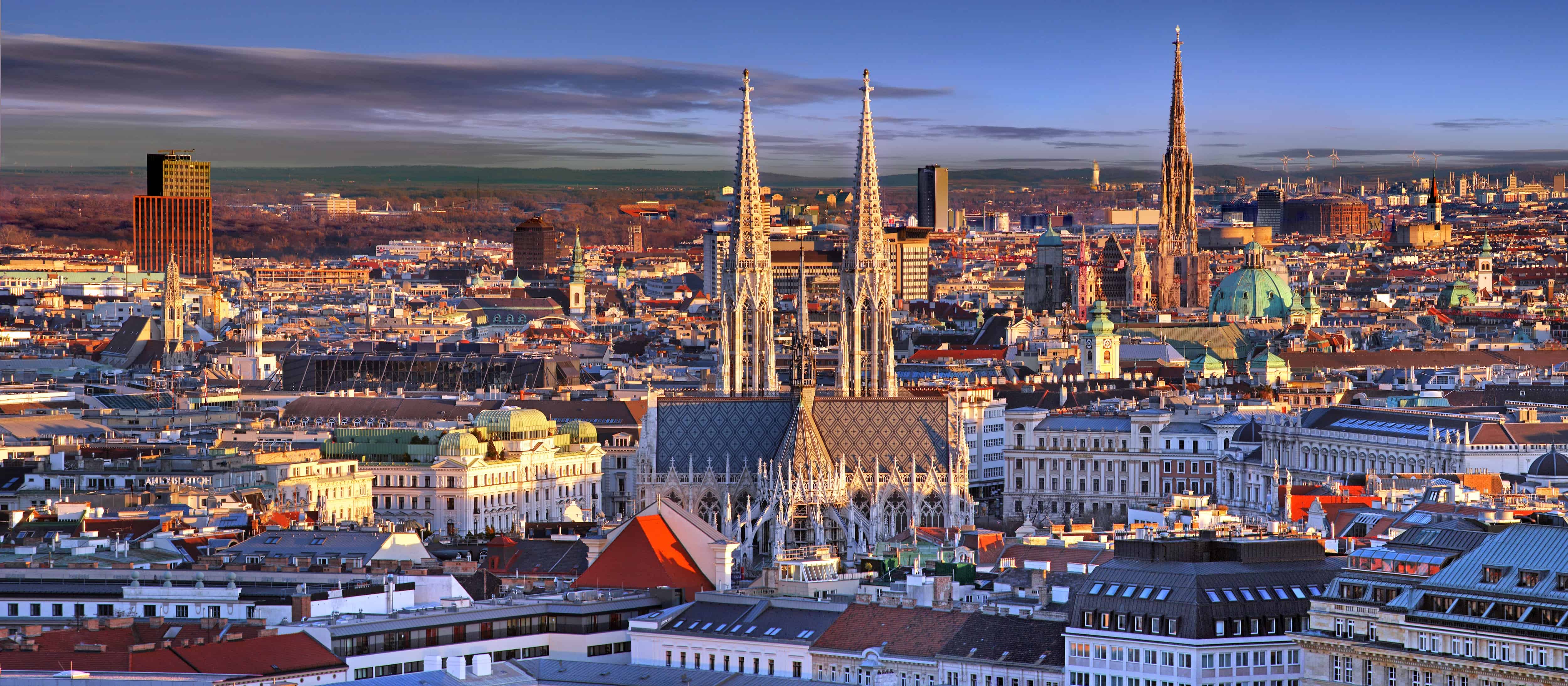As Austria’s beautiful capital city, Vienna is home to diverse architectural styles, with buildings ranging from medieval gothic cathedrals to unique and modernly designed flats; each structure is as rich and complex as Vienna itself.
Here are a few of our favourites that we’re sure you’ll appreciate as much as we do:
Stephansdom Cathedral

St. Stephen’s Cathedral, better known as Stephansdom Cathedral, was built more than 700 years ago by architect, Anton Pilgram. It remains a national symbol of Vienna as it holds the seat of the bishop, and is the city’s main Roman Catholic church. The 500-foot-tall South Tower rises well above the rest of Vienna’s skyline. Want to see the view from the top? Simply climb the 343 steps to get there. The North Tower houses Europe’s second largest free-swinging church bell, the Pummerin, weighing in at around 47,000 pounds. And from a distance, any on-looker will appreciate the colourfully-tiled roof – the tiles were placed to form the symbol of the double-headed eagle and Vienna’s coat of arms.
Address: Stephansplatz 3, 1010 Wien, Austria
Built: 1137
Architectural Style: Gothic
Schönbrunn Palace

We couldn’t possibly leave Schönbrunn Palace off the list. This extraordinary piece of architecture is Austria’s most visited tourist attraction and a UNESCO World Heritage Site, and get this: formerly the summer residence of the royal German family, the Habsburgs. It’s hard to believe that this 1,441-room palace was once a vacation home. It was originally built as an imperial hunting lodge for a 17th-century emperor, designed by architect, Johann Bernhard Fischer von Erlach. The surrounding park and gardens, free for visitors to explore year-round, is immaculately designed with statues, fountains, flowers, trees and the magnificent Gloriette, which is a sight to behold in and of itself. For a truly royal experience, visitors can enjoy a tea and pastry while admiring the incredible view of the palace and gardens at the Café Gloriette.
Address: Schönbrunner Schloßstraße 47, 1130 Wien, Austria
Built: 1700
Architectural Style: Baroque
Gasometers

What used to be Europe’s largest gas plant, consisting of four large gas containers, each 230 feet tall and 197 feet across, is now known as Vienna’s Gasometers. The gas plant was permanently shut down in 1984 when coal gas was replaced with the use of natural gas. The plant undertook an entire remodel in 1995, transforming the buildings into what they remain today – an incredible work of architecture and a hub of entertainment and activity for visitors. Designed by architects Jean Nouvel, Coop Himmelblau, Manfred Wehdorn and Wilhelm Holzbauer, each gas container is connected by a sky bridge and contains apartments, professional offices, a shopping mall, cinemas, shops, cafés and restaurants.
Address: Guglgasse 6, 1110 Wien, Austria
Built: 1899
Architectural Style: Industrial
Wotruba Church

Wotruba Church, which looks more like an unsteady Jenga tower than a religious sanctuary, is the creation of sculptor and architect, Fritz Wotruba. Formed by 152 concrete blocks, the church stands on Sankty Georgenberg, a small hill and former Nazi barracks, overlooking Vienna. Wortruba held a specific vision in mind while creating this masterpiece: he wanted to show that poverty doesn’t have to be ugly. This vision is seen in the simplicity of the design and the lush surrounding natural environment of grassland and trees. The completion of the project resulted in a wave of protest from the local community; many believed the peculiar design made it inappropriate to be considered a house of god. Today, the church is often frequented by tourists, intrigued by this massive work of art.
Address: Ottillingerpl. 1, 1230 Wien, Austria
Built: 1976
Architectural Style: Brutalist
Hundertwasserhaus

With brightly coloured walls, whimsical curves and ivy leaves climbing up the brick, it’s no wonder so many tourists flock to admire the striking architecture of the Hundertwasserhaus. This quirky block-long apartment complex, resembling something straight out of a Dr. Seuss book, was designed by Austrian painter and architect, Friedensreich Hundertwasser and Joseph Krawina. Known for his unique architectural style, Hundertwasser didn’t adhere to the restrictions of modern design. He aspired to create architecture that was harmonious with nature – Hundertwasserhaus wouldn’t be complete without its grass-covered rooftops and its inside-growing trees, sprouting out the windows. The building’s interior isn’t open to the public, but there’s the Hundertwasser Village across the street, a shopping centre and square also designed by Hundertwasser.
Address: Kegelgasse 36-38, 1030 Wien, Austria
Built: 1986
Architectural Style: Expressionist




